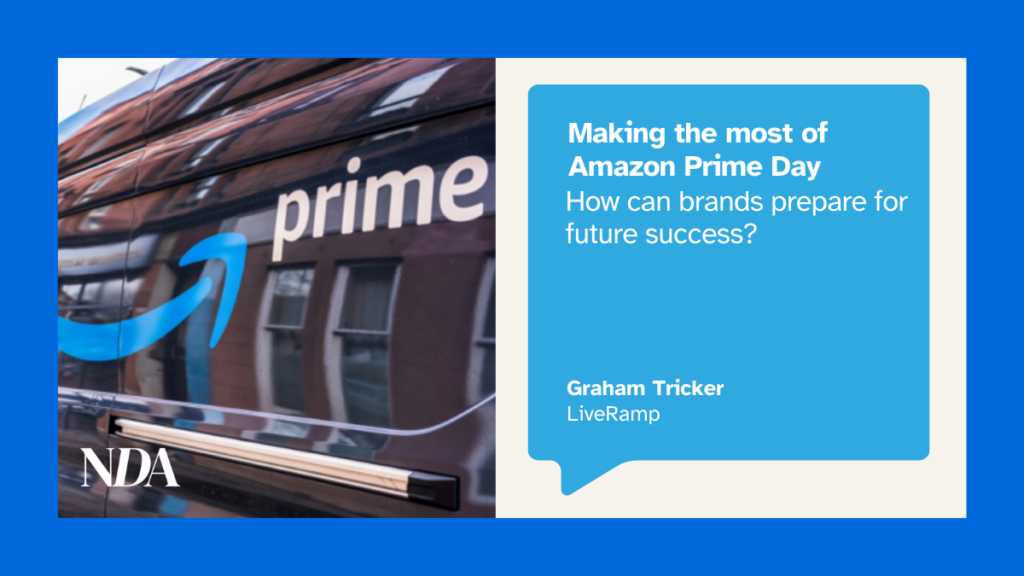By Graham Tricker, VP of Sales at LiveRamp
Originally launched in 2015 as a one-off, one-day event, almost a decade later Amazon Prime Day represents a critical fixture in the global retail diary.
Offering an invaluable window to increase brand awareness, onboard new customers, and significantly drive sales amongst high-value audiences with the propensity to spend, Prime Day’s popularity is a testament to the value of direct relationships with customers.
With this success, however, comes fierce competition. While retail inflation may have slowed in recent months, the lingering effects of the cost-of-living crisis means shoppers will continue to carefully consider their spending, including on Prime Days.
Ensuring that digital media is optimised, to speak to the right customer at the right time with the type of message they find valuable, should be the highest priority.
Indeed, the real key to the Prime Day opportunity for brands lies in making full use of the available customer data surrounding the event, to support a more complete overview and understanding of target audiences. This includes touchpoints within Amazon’s environments, but also outside of its walls, across the full range of clouds, warehouses, and other third-party clean rooms where customer data sits.
The key to this is data collaboration. Having the expertise as well as meaningful investment in the advanced technologies that can seamlessly connect all these datasets, from programmatic and media channels as well as walled gardens, will unlock more sophisticated cross-channel performance measurement, campaign incrementality, and journey-based affinities.
Data-led strategies
The most obvious way for a brand to leverage the timely opportunities of Prime Day is to increase its ad spend in the lead-up to, and through, the event. So, planning the allocation of the media budget carefully is essential, and this means understanding as much as possible about the target audience.
Some brands hold a lot of first-party customer data that can be analysed and activated. Enabling them to identify valuable customers and their interests, and to create targeted ads designed to appeal to those customers and others like them. However, many brands are not in this position and do not have huge amounts of customer data to draw on. This includes CPGs, which have their consumer relationships mediated via retailers. Amazon has historically addressed this by making its wealth of first-party customer data available to advertisers via its AWS clean room, which they can then use to make ad targeting more precise and improve advertising efficiency.
Today, the development of data clean room technology has meant that there are more solutions available, that brands can utilise to seamlessly unite datasets drawn from other clouds, warehouses, and clean room environments to gain unique insights. For example, this includes rich retail metrics like consumer buying behaviour, price sensitivity, and propensity to act on promotions, which can be used for better activations, informing media planning strategies and finding new, valuable audiences to target in the future. Not to mention build more direct and lasting relationships with their current customers.
Furthermore, through better permissioning and control of data movement within these clean rooms, retail businesses can also ensure that these insights are immediately translatable, costs are kept low, and media is running the most efficiently it can on Prime Day. This is alongside transparent and near real-time reporting, which are essential when tracking spend performance across the retail event (as well as for justifying costs to stakeholders).
Investment and experimentation
Success in data collaboration takes time and having the necessary soft skills in place will serve the business well in the long-term. Experimentation, configuring, testing, and education of the business to leverage data collaboration effectively should be an ongoing process. This includes working with the right partners and onboarding those with the right expertise, especially professionals with data science proficiencies.
Those hoping to make the most of future Amazon Prime Days are advised to strategically increase their business’s ability to engage with data collaboration, and enjoy the full range of customer insights that are available, within Amazon’s clean room, other privacy-centric clean rooms and across the full range of channels / data environments, to continue to reach high-value audiences.
*LiveRamp is a client of Bluestripe Communications, owned by Bluestripe Group, owner of NDA









